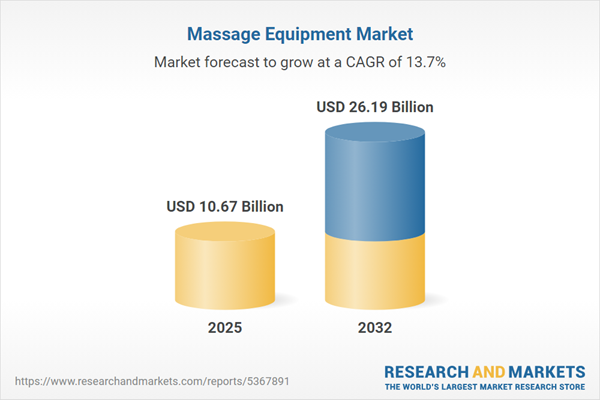Speak directly to the analyst to clarify any post sales queries you may have.
The massage equipment market is poised for significant expansion as evolving health priorities, technological advancements, and shifting consumer behaviors fuel new opportunities for businesses and investors. Senior decision-makers will benefit from a data-driven view of emerging channels, regulatory developments, and innovation strategies shaping this rapidly evolving sector.
Market Snapshot: Massage Equipment Market Size and Growth Outlook
The massage equipment market grew from USD 9.40 billion in 2024 to USD 10.67 billion in 2025. It is expected to continue expanding at a CAGR of 13.65%, ultimately reaching USD 26.19 billion by 2032. This sustained growth is underpinned by rising wellness awareness, demographic shifts emphasizing non-invasive pain management, and heightened demand for smart, connected therapeutic devices across a range of user segments.
Scope & Segmentation
The report provides comprehensive coverage of the massage equipment market, encompassing product innovations, new channel strategies, and evolving consumer trends across major geographies and use cases.
- Product Types: Foot massager, handheld massager, massage chair, massage gun, massage mat, massage table
- Applications: Home, medical (clinics, hospitals), professional (beauty salon, physiotherapy, spa use)
- End Users: Commercial, residential
- Distribution Channels: Offline, online retailers (including e-commerce marketplaces, manufacturer websites)
- Regions: Americas (North America, Latin America), Europe, Middle East & Africa (Europe, Middle East, Africa), Asia-Pacific (China, India, Japan, Australia, South Korea, Indonesia, Thailand, Malaysia, Singapore, Taiwan)
- Key Industry Players: Includes OSIM International Ltd., Panasonic Corporation, Fujiiryoki Co., Ltd., Human Touch LLC, HoMedics LLC, Johnson Health Tech Co., Ltd., Cozzia USA Inc., Luraco Technologies LLC, OTO LifeTech Pte. Ltd., Hyperice Inc.
Key Takeaways for Decision Makers
- Growth is driven by rising consumer emphasis on preventive health, with mainstream adoption shifting massage equipment beyond niche therapeutic applications.
- Proliferation of at-home solutions and digital wellness integrations has enhanced end-user engagement and enabled remote or self-guided recovery methods.
- Dynamic product innovation, including IoT and AI integration, differentiates offerings in competitive markets and elevates both end-user personalization and equipment performance.
- Regulatory standards and compliance requirements continue to evolve, especially within clinical and medical-use channels, reinforcing the need for robust testing and certification.
- Omnichannel distribution strategies and partnerships with local suppliers or services are essential to meeting diverse regional requirements and expanding market reach.
Tariff Impact on Supply Chains
The introduction of United States tariffs in 2025 has led to structural changes within the massage equipment value chain. Companies are adapting sourcing and cost strategies, with a notable shift toward diversifying manufacturing bases. This complexity requires new logistics approaches as organizations mitigate supply risks, manage pricing fluctuations, and evaluate nearshoring to boost resilience against trade-related disruptions.
Methodology & Data Sources
The report's insights are supported by a rigorous methodological framework combining primary interviews with stakeholders, secondary research from industry reports and filings, and advanced validation techniques such as data triangulation. An expert review panel further refines findings to ensure robust, actionable guidance.
Why This Report Matters
- Offers an in-depth segmentation analysis, enabling targeted strategies suited to distinct regional, application, and channel dynamics.
- Delivers a nuanced understanding of technological and policy trends relevant for innovation planning and compliance alignment.
- Empowers leaders to identify sustainable opportunities and navigate volatility in sourcing, partnerships, and customer engagement.
Conclusion
The massage equipment market presents diverse opportunities shaped by evolving user needs, regulatory shifts, and ongoing innovation. Decision-makers equipped with strategic insights and reliable data are best positioned to drive sustainable performance in this competitive arena.
Additional Product Information:
- Purchase of this report includes 1 year online access with quarterly updates.
- This report can be updated on request. Please contact our Customer Experience team using the Ask a Question widget on our website.
Table of Contents
3. Executive Summary
4. Market Overview
7. Cumulative Impact of Artificial Intelligence 2025
Companies Mentioned
The companies profiled in this Massage Equipment market report include:- OSIM International Ltd.
- Panasonic Corporation
- Fujiiryoki Co., Ltd.
- Human Touch LLC
- HoMedics LLC
- Johnson Health Tech Co., Ltd.
- Cozzia USA Inc.
- Luraco Technologies LLC
- OTO LifeTech Pte. Ltd.
- Hyperice Inc.
Table Information
| Report Attribute | Details |
|---|---|
| No. of Pages | 189 |
| Published | October 2025 |
| Forecast Period | 2025 - 2032 |
| Estimated Market Value ( USD | $ 10.67 Billion |
| Forecasted Market Value ( USD | $ 26.19 Billion |
| Compound Annual Growth Rate | 13.6% |
| Regions Covered | Global |
| No. of Companies Mentioned | 11 |









